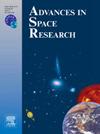基于差分演化的多帧混合积分方法用于gnss无源雷达机动目标检测
IF 2.8
3区 地球科学
Q2 ASTRONOMY & ASTROPHYSICS
引用次数: 0
摘要
目前针对全球导航卫星系统(GNSS)无源雷达提出的目标检测方法主要针对非机动目标,利用二阶多项式模型对长积分时间内目标回波的运动偏移进行校正。然而,目前这些方法的检测性能下降,当应用于机动目标时,因为他们不能解决高阶运动迁移。本文主要研究机动目标检测问题。首先,我们评估了三阶多项式模型(TPM)在逼近机动目标双基地距离历史上的适用性。在此基础上,分析了基于gnss的无源雷达在TPM、距离分辨率和多普勒分辨率方面需要进行哪些高阶运动偏移校正。在此基础上,提出了一种多帧混合集成机动目标检测方法。将该方法的实现表述为双基地参数搜索空间中的约束优化问题,并采用差分进化方法提高处理效率。仿真和实际实验结果均证实了该方法的有效性。蒙特卡罗实验表明,该方法需要比现有方法至少低2 dB的信噪比阈值才能达到相同的检测概率为0.9。本文章由计算机程序翻译,如有差异,请以英文原文为准。
A multi-frame hybrid integration method combined with differential evolution for maneuvering target detection with GNSS-based passive radar
Current target detection methods tailored for global navigation satellite system (GNSS)-based passive radar are primarily put forward for non-maneuvering targets and utilize a second-order polynomial model to correct motion migrations of the target return during the long integration time. However, the detection performances of these current approaches diminish when applied to maneuvering targets, as they fail to address the high-order motion migrations. This study concentrates on maneuvering target detection issue. First, we evaluate the applicability of a third-order polynomial model (TPM) for approximating the bistatic range history of the maneuvering target. Then, we analyze which high-order motion migration corrections are necessary in terms of the TPM and the range and Doppler resolutions of GNSS-based passive radar. Based on this analysis, we propose a multi-frame hybrid integration method to detect maneuvering target. The realization of the proposed method is formulated as a constrained optimization problem in the bistatic parameter searching space, for which differential evolution is employed to improve processing efficiency. Both simulated and real experimental results confirm the effectiveness of the proposed method. Monte Carlo trials demonstrate that the proposed method needs a signal-to-noise ratio threshold at least 2 dB lower than the existing methods to achieve the same detection probability of 0.9.
求助全文
通过发布文献求助,成功后即可免费获取论文全文。
去求助
来源期刊

Advances in Space Research
地学天文-地球科学综合
CiteScore
5.20
自引率
11.50%
发文量
800
审稿时长
5.8 months
期刊介绍:
The COSPAR publication Advances in Space Research (ASR) is an open journal covering all areas of space research including: space studies of the Earth''s surface, meteorology, climate, the Earth-Moon system, planets and small bodies of the solar system, upper atmospheres, ionospheres and magnetospheres of the Earth and planets including reference atmospheres, space plasmas in the solar system, astrophysics from space, materials sciences in space, fundamental physics in space, space debris, space weather, Earth observations of space phenomena, etc.
NB: Please note that manuscripts related to life sciences as related to space are no more accepted for submission to Advances in Space Research. Such manuscripts should now be submitted to the new COSPAR Journal Life Sciences in Space Research (LSSR).
All submissions are reviewed by two scientists in the field. COSPAR is an interdisciplinary scientific organization concerned with the progress of space research on an international scale. Operating under the rules of ICSU, COSPAR ignores political considerations and considers all questions solely from the scientific viewpoint.
 求助内容:
求助内容: 应助结果提醒方式:
应助结果提醒方式:


